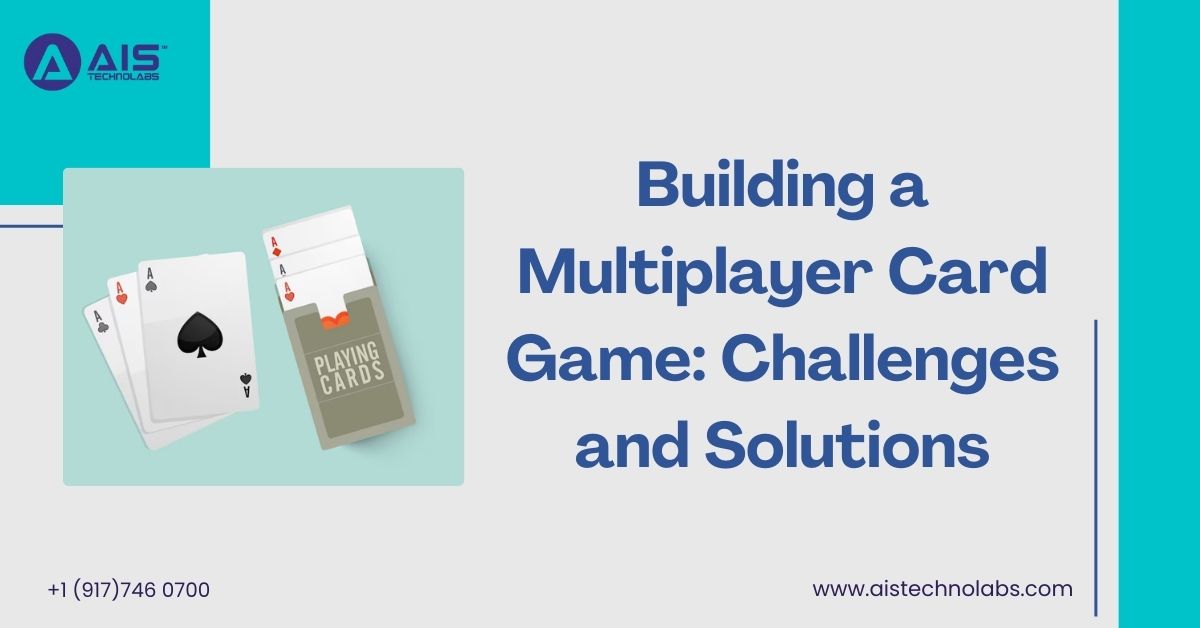Table of Content
(500 views)

Introduction
The multi-player card game market is afire, fueled by gamers' demands for more immersive, more interactive gaming experiences. Card game development has never been more complicated and competitive. Creating a multi-player card game is not coding up mechanics—it's a test of overcoming technical, design, and business hurdles to deliver silky smooth gameplay, fair competition, and profitability over the long term.
But how do you build a hit multi-player card game? From second-to-second feedback to secure transactions, there are so many things to overcome before coders can provide an unprecedented degree of gaming pleasure. In this article, we will outline the biggest challenges with building a card game and provide helpful tips so that you too can build a successful product.
Major Challenges in Card Game Development
1. Real-Time Synchronization and Lag Issues
Seconds count in multi-player. The gamers expect live game play with no lag and spikes in delay. But real-time synchronizing across internet speeds and devices is a serious challenge.
Solution:
- Use web sockets or TCP-based connections to minimize latency.
- Implement lag compensation techniques like predictive modeling to ensure smooth game play.
- Optimize server architecture with load balancing to handle high traffic effectively.
2. Secure and Fair Gameplay
There needs to be a cheating and hacking-free multiplayer card game. The game must be equitable to aid in the building of trust and communication with the players.
Solution:
- Use strong encryption methods to protect the player's data.
- Use AI-powered anti-cheat technology to watch for unusual play activity.
- Use blockchain so that payments can be transparent and the cards can be randomly shuffled.
3. Cross-Platform Compatibility
Players are able to play from various devices like PCs, mobiles, and tablets. The game must be fully compatible with all platforms by the developers.
Solution:
- Develop the game on a cross-platform engine like Unity or Unreal Engine.
- Make graphics and performance optimized on low-end and high-end hardware.
- Save the game on devices with cloud storage of data.
4. Immersive User Interface (UI) and Experience (UX)
A good UI/UX keeps players. Poor design or awful controls lose players.
Solution:
- Use intuitive controls and good graphics.
- Use smooth animations and transitions.
- Use an interactive tutorial to onboard new players correctly.
5. Scalability and Server Load Management
As your game becomes more popular, so will the number of players online at the same time. Sloppily tuned servers will result in crashes, lag, and a bad player experience.
Solution:
- Scale dynamically on cloud-hosting solutions like AWS or Google Cloud.
- Utilize distributed databases to manage player records efficiently.
- Continuously monitor server performance and conduct stress testing.
6. In-Game Monetization Strategies
Monetization is an important aspect of developing multiplayer card games. Choosing a monetization model guarantees profitability without sacrificing user experience.
Solution:
- Leverage in-app purchases like personalized card packs, avatars, and power-ups.
- Apply a freemium model with premium offerings presented as an option.
- Use subtle ads and sell an ad-free version.
7. Legal and Regulatory Compliance
There are local regulations on online gambling, gaming, and financial transactions in every area. Not adhering to them may create legal issues and bans.
Solution:
- Learn well about local and global laws of gaming.
- Get proper certifications and licenses.
- Implement age restrictions and responsible gaming options.
Steps to Develop a Multiplayer Card Game
Step 1: Market Research and Game Planning
- Study your rival games and discover market gaps.
- Choose your target user segment and preferred card game variant (Poker, Rummy, etc.).
- Develop a feature roadmap, UI design, and monetization plan.
Step 2: Selecting the Perfect Tech Stack
- Use programming languages like JavaScript, Python, or C++.
- Choose a game engine (Unity, Unreal Engine, or custom implementations).
- Use web socket-based real-time communication.
Step 3: Game Infrastructure Design
- Use server-client architecture to enable smooth multiplayer interaction.
- Create a database of player profile, rank, and game history.
- Host on cloud hosting to enable scalability.
Step 4: Development of Core Game Mechanic
- Create the game logic for shuffling and dealing of cards and the rules of the game.
- Add animations and graphics to improve the game.
- Add RNG (Random Number Generator) for randomness to ensure a fair game.
Step 5: Implementation of Security Features
- Securely encrypt user transactions and data.
- Add anti-fraud detection algorithms.
- Enforce two-factor authentication for logins.
Step 6: Testing and Debugging
- Beta test on a focused group of players.
- Debug and balance gameplay performance.
- Stress test servers.
Step 7: Deployment and Marketing
- Deploy the game on multiple platforms (Web, Android, iOS).
- Perform focused marketing via advertisements and social media.
- Deploy periodic updates with new functionality and patches.
Build Your Multiplayer Card Game with Experts!
Conclusion
It is not easy but worthwhile work to design a multiplayer playing card game. Ranging from real-time synchronism to the right use of security, every action calls for thought-out planning and thorough effort. Deploying proper technology and beating the most tricky obstacles can help you build an upscale game popular enough to acquire patrons and earnings.
At AIS Technolabs, we specialize in creating card games and offer the latest solutions to implement your idea. Do you require an expert to work for you or an entire gaming platform? We are capable of delivering that. Contact us today to implement your idea.
Disclaimer:
This blog is intended for informational and educational purposes only. We do not promote or facilitate gambling activities in any country where it is considered illegal. Our content is focused solely on providing knowledge about legal and regulated markets. We only work with operators and platforms that are licensed and comply with the laws of jurisdictions where casino gaming is permitted. We do not operate or endorse any form of gambling in restricted regions. In countries where only skill-based games are allowed, our involvement is strictly limited to those games.
We believe gambling should be an entertaining and responsible activity. Our goal is to ensure that the platforms we review uphold the highest standards of fairness, transparency, and player safety.
FAQs
Ans.
Development time depends on features, complexity, and platform compatibility. Average time is 3–6 months for a bare minimum release and one year or more for a feature-packed game.
Ans.
Suggested technologies are Unity or Unreal Engine for game development, WebSockets for real-time communication, and AWS or Google Cloud for scalable hosting.
Ans.
With blockchain-based openness, AI-based anti-cheating, and RNG (random number generator), it is possible to offer a level playing field.
Ans.
Freemium, subscription-based, in-app purchases, and in-game advertisements are the most appropriate monetization models.
Ans.
AIS Technolabs provides full-cycle card game development solutions, from conceptualization and design to deployment and support. Reach out to us to start with it!
Mary Smith
Mary Smith excels in crafting technical and non-technical content, demonstrating precision and clarity. With careful attention to detail and a love for clear communication, she skillfully handles difficult topics, making them into interesting stories. Mary's versatility and expertise shine through her ability to produce compelling content across various domains, ensuring impactful storytelling that resonates with diverse audiences.
